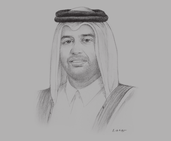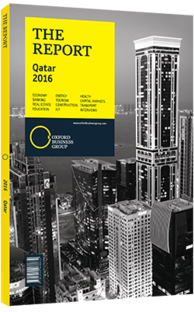Sheikh Ahmed bin Jassim bin Mohamed Al Thani, Minister of Economy and Commerce; and Vice-Chairperson, Qatar Investment Authority: Interview

Interview: Sheikh Ahmed bin Jassim bin Mohamed Al Thani
What does the Ministry of Economy and Commerce (MEC) plan to do to reduce red tape and attract foreign direct investment (FDI)?
SHEIKH AHMED JASSIM BIN MOHAMED AL THANI: As you may be aware, Qatar has taken considerable legislative measures designed to strengthen the foreign investment framework. These measures fall under two main pillars: the first focuses on widening the gate for foreign investors, while the second aims to simplify procedures and make it easier to establish a business. Regarding the first pillar, Qatar has established an attractive legal framework that allows foreign investors full ownership of businesses in certain sectors and a competitive tax environment, which consists of a flat 10% corporate tax rate on locally sourced profits, no withholding tax, no personal income tax, no wealth tax and no value-added tax. This legal and tax climate has positioned Qatar as the most competitive economy in the Middle East and in 14th place worldwide, according to the World Economic Forum’s “Global Competitiveness 2015-16” report. Qatar is also ranked as the 20th most important financial centre in the world, as per the recently published Global Financial Centres Index.
In addition, we believe that the development of special economic zones and a private-public partnership (PPP) framework, among other potential initiatives the MEC is currently working on, will enlarge the scope of foreign investors’ involvement in Qatar’s economy. Of equal importance is our commitment to strengthening the business environment and to simplifying procedures for activities such as setting up a business. To this end, a new commercial company law has been in place since June 2015. This is an early example of the procedural and legislative measures that the MEC will be considering in the coming years.
We already have an accommodating approach to updating business legislatives and operations, taking into consideration the changing business environment across pioneer countries around the world. However, updating the operational framework for setting up businesses is an ongoing process that is built upon Qatar’s frequent assessment of the domestic business environment and a clear diagnosis of the challenges faced by foreign and domestic investors. These efforts are executed within a harmonised framework, which includes all relevant governmental and regulatory bodies in the country.
How do you aim to counter the falling FDI inflows Qatar has been experiencing in recent years?
SHEIKH AHMED: Without a doubt, the negative growth prospects of the global economy, together with geopolitical concerns, have adversely affected investor and consumer confidence throughout the world. One ramification of these low confidence levels was seen with the slowdown in global FDI flows in 2014, which could last for years if such circumstances persist. The world’s current economic environment suggests that the observed fall in commodity prices will affect the inflow of FDI not only to oil-exporting countries but also to non-oil commodity exporters. Hence, falling FDI is a global phenomenon that is not limited to a particular country or region.
However, it is worth mentioning that while Qatar attempts to improve its business environment to attract foreign investment, FDI has not yet played as much of a dominant role in our economy as domestic investment has. In the first three quarters of 2015, FDI inflows to Qatar amounted to approximately QR3bn ($832.2m), close to those observed over the same period of 2014. Gross domestic capital formation, on the other hand, reached QR120bn ($32.9bn) in only the first two quarters of 2015.
However, over the medium and long term, Qatar hopes to increase the role of FDI as one of the main drivers of economic development. To achieve this, we are counting on continued improvement to the country’s soft and hard infrastructure. The promising projects that will take place in the special economic zones, and those under the new PPP framework, are likely to provide attractive opportunities for foreign investors. Moreover, the government’s commitment to continuing with its investment plans suggests that growth prospects for the Qatari economy may not be seriously affected by falling energy prices.
With the highest savings rate in the world (over 50% of GDP), Qatar has built up significant fiscal and external buffers to withstand lower oil prices and continue its diversification process. Despite lower oil prices, Qatar’s real economic growth remains strong due to the expansion of the non-hydrocarbons sector. All this will motivate foreign investors, and may counter some of the repercussions of falling commodity prices and geopolitical concerns.
In light of low oil and gas prices, how is the MEC prioritising economic diversification in 2016?
SHEIKH AHMED: I should first emphasise that Qatar’s focus on its economic diversification strategy has not been particularly influenced by the recent fall in global oil prices. Qatar launched its strategy several years ago, and current global conditions confirm the importance of this policy. Qatar’s non-hydrocarbons sector accounts for almost half of the country’s GDP, having risen from 45% in 2008 to 49% in 2014. During the fourth quarter of 2015, the real output of the non-hydrocarbons sector grew by 7.4% compared to the same quarter in 2014.
The framework, which directs our diversification policy, focuses mainly on activities that generate sustained and high value-added. We are currently conducting a comprehensive assessment of Qatar’s business environment, taking into consideration all institutional, operational and production-related aspects. Through this comprehensive assessment, we will come up with a list of activities that will have the highest potential to grow and sustain the national economy. The identification of potential activities would not only be useful for interested investors but, more importantly, to all governmental bodies so they can align their policies to support such activities.
Which countries offer Qatar the greatest potential to boost its import and export figures?
SHEIKH AHMED: The dynamics of global markets suggest that every country, regardless of whether it is primarily an importer or exporter, should follow a diversified and adaptive approach to international trade. However, the current global economic conditions suggest that emerging markets have a high trade potential on the demand and supply side.
As you may know, the Asian market receives more than 70% of our exports. Some Asian countries are among the leading emerging economies in the world and, despite the current negative global prospects, they still have a relatively long high-growth horizon. In any case, Qatar’s export destinations have widened in recent years, which means we are less exposed to regional vulnerability. Despite the fall in oil and gas prices, Qatar continues to run a strong trade surplus, which registered QR163bn ($44.7bn) in 2015. In the short term, I do not think there will be a significant change to the countries Qatar exports to, but others may join the list, depending on economic conditions.
Regarding supply, Qatar has a more geographically diversified import portfolio, with Asia and the EU accounting for almost two-thirds of total imports. However, a further shift toward China and other emerging countries may arise, particularly in light of excess capacity in these countries and the expected depreciation of their currencies, which would translate into lower export prices. Accordingly, since Qatar has a liberal approach to international trade, these factors could have an influence on import sources. Again, though, no one should predict a drastic change to our bilateral trade portfolio in the short term.
You have reached the limit of premium articles you can view for free.
Choose from the options below to purchase print or digital editions of our Reports. You can also purchase a website subscription giving you unlimited access to all of our Reports online for 12 months.
If you have already purchased this Report or have a website subscription, please login to continue.

